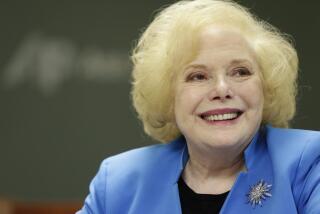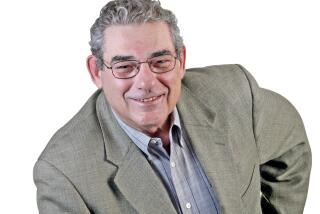The Grande Dame of L.A. Newspapers
She was one of America’s most colorful and remarkable journalists, the grande dame of Los Angeles newspapering, and the first female city editor of a major metropolitan paper.
Agness Underwood--Aggie to her colleagues and the whole city--was a crusty, tough-talking woman who ruled the city’s news appetite with a combination of toughness, professional know-how and sentimentality. She was a mother of two who cooked her special spaghetti not only for her kids, but for Errol Flynn and Mickey Cohen.
But it was the city newsroom crew at the Los Angeles Herald-Express--forerunner of the now-defunct Los Angeles Herald Examiner--that benefited most from Underwood’s generosity; whenever the temperature inside the old building reached 100 degrees, she ordered up cold beers.
Like a good beer, the journalism she served up from 1926 to 1968 was brewed for working-class tastes. It was a time when female reporters were openly called “broads” by their own colleagues, and scandal-hungry reporters measured success by the size of their hangovers.
Los Angeles was a city with six newspapers that competed at all costs for crime scoops and juicy Hollywood gossip. The Herald-Express produced up to eight editions a day, and Underwood tried to make each one newsier and more entertaining than the last.
*
In a career spanning more than four decades, she earned a reputation for knowing the middle names, the private phone numbers and many of the carefully guarded secrets of everyone from police chiefs to gangsters to movie stars.
Underwood was born in San Francisco four years before the 1906 earthquake. Orphaned at 6, she was raised mainly in foster homes. To protect her little sister, she poured a bottle of catsup over the head of one abusive foster mother. By age 16, she moved to Hollywood to live with an aunt, only to return home after work one day to find her clothes wrapped in newspaper on the front porch and her aunt gone.
She was living at a Salvation Army home and working as a waitress for $11 a week when she met Harry Underwood, a soda jerk, whom she married in 1920 and divorced in 1940.
In 1926, two children later, tired of adhering to a no-frills budget and hankering for a pair of real silk stockings, she went to work as a switchboard operator at the Los Angeles Record, the smallest of the city’s dailies.
By looking over reporters’ shoulders and practicing her four-finger typing for more than a year, she was ready in 1927 for the city’s biggest murder story of the year--the grisly kidnapping-murder of a 9-year-old girl. The city editor dictated the story to Underwood because she could type fast--and she was hooked. After landing several exclusive crime interviews, the switchboard operator was put on the payroll as a reporter.
In 1935, after a decade of bucking male reporters and scooping the rival Herald-Express, the Herald hired her as its police and court reporter, with a $2 raise to $27 a week.
One of the first stories she covered was the still-mysterious death of actress and comedienne Thelma Todd, whose body was found in her parked car at her Malibu restaurant. After watching Todd’s autopsy, Underwood looked around at the bodies of dead men covered by white sheets and quipped: “Can you imagine what any of these guys would have given to be under a sheet with Thelma Todd?”
Aggie prided herself on christening murder cases with catchy names. In a moment of inspiration--and calculation--she dropped a white carnation on the body of a waitress who had been stabbed to death, just to give the story a name: “The White Carnation Murder.” When she told her photographer to take a picture of her creation, a cop objected--and Underwood smacked him with her purse. Later, as a city editor, she expected her reporters to be no less aggressive--or inventive.
She scored a scoop with her interview of a yacht tragedy survivor who cannibalized her shipmates. Mobster Cohen called her every time he landed in jail to give her an exclusive, and phoned when he was hungry for one of her spaghetti dinners.
Because her ultimate command of the news business was just as remarkable as her entry into it, she was named the first woman city editor of the Herald-Express in 1947.
She stood at her desk looking out over her crew like a galley slave master, shouting out orders or encouragement in a voice that, as someone said, would seduce only a foghorn.
*
And when things got too quiet in the city room, she fired off blanks from a pistol she stored in her desk drawer. A baseball bat also sat nearby to keep overzealous Hollywood press agents in line.
At a time when women journalists were not allowed to join the National Press Club, she won scores of awards, ranging from “most outstanding woman in journalism” from the National Federation of Press Women to the Los Angeles Times’ first Woman of the Year in professional journalism. She was named in the first edition of Who’s Who of American Women in 1959, and Ralph Edwards featured her on his national TV show “This Is Your Life.”
Even with all the public adulation, she was bitter at her treatment by her bosses at William Randolph Hearst’s newspapers. “I can’t recall one Hearst executive ever saying ‘nice work’ over a story I’d covered . . . or even buying me an ice cream cone on my birthday. So help me.”
In 1964, two years after the Herald-Express merged with the Examiner, the Her-Ex gang moved into the Examiner building at 11th Street and Broadway, and Underwood was kicked upstairs as assistant managing editor.
But for the woman who returned early from vacations to get back to work, the inactivity was too much.
*
For four years, she wandered around like a “half-assed executive,” she said. So, after 33 years of service and increasing circulation for the Hearst papers, she retired.
At her retirement party in 1968, the Hollywood Palladium was overflowing. Telegrams came in from mayors, senators, governors and President Lyndon B. Johnson. Bob Hope emceed.
But retirement didn’t quiet her. In 1981, she filed a $110-million defamation suit, claiming she was falsely portrayed in the book “The Last Mafioso” as having helped Cohen steal $1 million. A judge dismissed the suit, saying the statements were “mere opinions.” Three years later, a state appeals court granted a rehearing, but Underwood died in 1984 before the case was resolved. She was 81.
Underwood said of her trade: “A good story is a good story. And you fill the holes with putty if you can’t make it hold together.”
A onetime employee of hers, the late Times columnist Jack Smith, elaborated: “Aggie always reminded me of an old rhyme that used to be painted on the wall of a doughnut shop at 8th and Olympic. ‘As o’er life’s road you roll / Keep your eye upon the doughnut, and not upon the hole.’ ”
More to Read
Sign up for Essential California
The most important California stories and recommendations in your inbox every morning.
You may occasionally receive promotional content from the Los Angeles Times.










